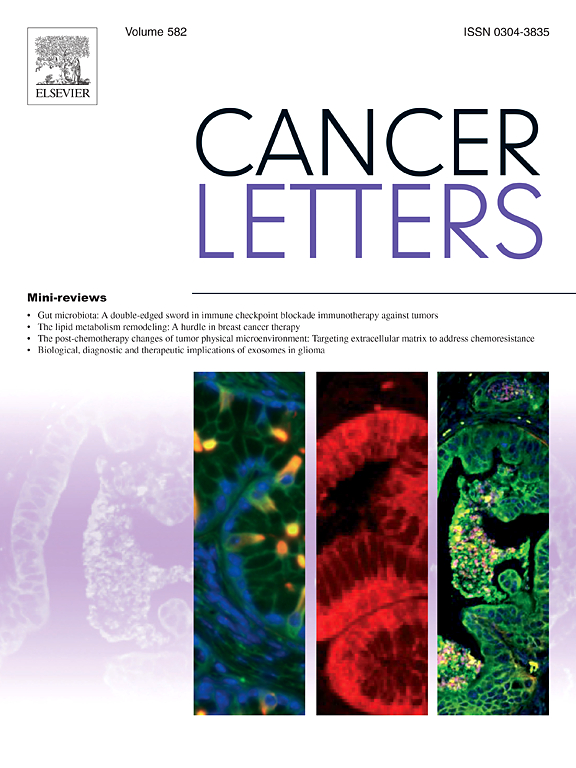Multimodal radiopathological integration for prognosis and prediction of adjuvant chemotherapy benefit in resectable lung adenocarcinoma: A multicentre study
IF 9.1
1区 医学
Q1 ONCOLOGY
引用次数: 0
Abstract
Lung adenocarcinoma (LUAD) has a heterogeneous prognosis and controversial postoperative treatment protocols. We aim to develop and validate a multimodal analysis framework that integrates CT images with H&E-stained whole-slide images (WSIs) to enhance risk stratification and predict adjuvant chemotherapy benefit in LUAD patients. We retrospectively collected data from 1039 resectable LUAD patients (stage I–III) across four centres, forming a training dataset (n = 303), two testing datasets (n = 197 and n = 228) for survival analysis, and a feature testing dataset (n = 311) for interpretability analysis. We extracted 487 tumour/peritumour radiomics features from CT images and 783 multiscale pathomics features from WSIs, characterising the shape of tumour (CT) and cancer nuclei (WSIs), as well as the intensity and texture of tumour/peritumour regions (CT) and tumour regions/epithelium/stroma (WSIs). A survival support vector machine (SVM) was employed to establish a radiopathomics signature using the optimal set of multimodal features, including 2 tumour radiomics features, 3 peritumour radiomics features, and 4 nuclei heterogeneity pathomics features. The radiopathomics signature outperformed both radiomics and pathomics signatures in predicting disease-free survival (DFS) (C-index: training dataset, 0.744 vs. 0.734 and 0.692; testing dataset 1, 0.719 vs. 0.701 and 0.638; testing dataset 2, 0.711 vs. 0.689 and 0.684), demonstrating greater robustness compared to the state-of-the-art deep learning integration approaches. It provided additional prognostic information beyond clinical risk factors (C-index of clinical plus radiopathomics vs. clinical models: training dataset, 0.763 vs. 0.676; testing dataset 1, 0.739 vs. 0.676; testing dataset 2, 0.711 vs. 0.699, p < 0.001). Compared to low-risk patients categorised by the radiopathomics signature, high-risk patients achieved comparable DFS when receiving adjuvant chemotherapy (training dataset, HR = 1.53, 95 % CI 0.85–2.73, p = 0.153; testing dataset 1 and 2, HR = 1.62, 95 % CI 0.92–2.85, p = 0.096), but had significantly worse DFS when only observed after surgery (training dataset, HR = 4.46, 95 % CI 2.82–7.05, p < 0.001; testing datasets 1 and 2, HR = 3.52, 95 % CI 2.26–5.49, p < 0.001), indicating the predictive value of the radiopathomics signature for adjuvant chemotherapy benefit (interaction p < 0.05). Further interpretability analysis revealed that the radiopathomics signature was associated with various prognostic/treatment-related biomarkers, including differentiation, immune phenotypes, and EGFR status. The multimodal integration framework offered a cost-effective approach for LUAD characterisation by leveraging complementary information from radiological and histopathological imaging. The radiopathomics signature demonstrated robust prognostic capabilities, providing valuable insights for postoperative treatment decisions.
求助全文
约1分钟内获得全文
求助全文
来源期刊

Cancer letters
医学-肿瘤学
CiteScore
17.70
自引率
2.10%
发文量
427
审稿时长
15 days
期刊介绍:
Cancer Letters is a reputable international journal that serves as a platform for significant and original contributions in cancer research. The journal welcomes both full-length articles and Mini Reviews in the wide-ranging field of basic and translational oncology. Furthermore, it frequently presents Special Issues that shed light on current and topical areas in cancer research.
Cancer Letters is highly interested in various fundamental aspects that can cater to a diverse readership. These areas include the molecular genetics and cell biology of cancer, radiation biology, molecular pathology, hormones and cancer, viral oncology, metastasis, and chemoprevention. The journal actively focuses on experimental therapeutics, particularly the advancement of targeted therapies for personalized cancer medicine, such as metronomic chemotherapy.
By publishing groundbreaking research and promoting advancements in cancer treatments, Cancer Letters aims to actively contribute to the fight against cancer and the improvement of patient outcomes.
 求助内容:
求助内容: 应助结果提醒方式:
应助结果提醒方式:


